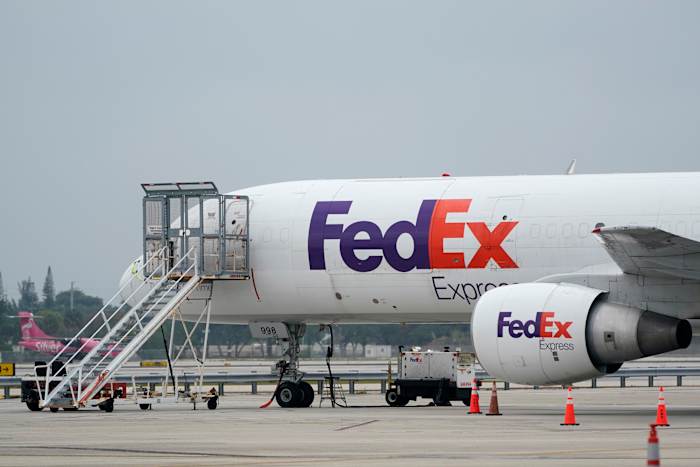U.S. Airports Could Strain Air Cargo as Peak Holiday Season Approaches
Several U.S. airports with major package distribution centers are expected to reduce capacity, potentially impacting air cargo just as the peak holiday shopping season nears. Among them are key hubs for FedEx and UPS, raising concerns for logistics amid rising demand.
FedEx operates major hubs in Indianapolis and Memphis, Tennessee, while UPS’s largest hub, Worldport, is located in Louisville, Kentucky — the site of this week’s deadly cargo plane crash. The tragic accident at UPS Worldport on Tuesday killed 14 people, including the three pilots aboard the MD-11 aircraft bound for Honolulu.
MD-11 aircraft comprise about 9% of UPS’s fleet and 4% of FedEx’s, according to company statements. Despite these setbacks, logistics companies have reassured consumers that package delays are not expected immediately, though the reduction in flights adds strain to the supply chain during this critical time.
Patrick Penfield, a supply-chain management professor at Syracuse University, described the combined 10% reduction in flight capacity alongside the MD-11 grounding as a “one-two punch” for both cargo carriers and shoppers.
“This is such a stressful time for companies already facing a surge in demand,” Penfield said. “Losing some capacity now means they’re scrambling even more during the holiday season.”
Penfield anticipates it could take weeks for UPS and FedEx to return their MD-11 fleets to service following thorough safety reviews. He warns that during mid-December, when shipping peaks, customers might experience delivery delays of a day or two and recommends ordering holiday gifts early.
Domestic Flight Capacity Reductions and Impact
The FAA has ordered a 10% reduction in total daily scheduled domestic operations from 6 a.m. to 10 p.m. local time at 40 airports. However, this reduction currently affects only domestic flights, not international routes. Air freight is transported not only on dedicated cargo planes but also in the cargo holds of passenger aircraft.
Airlines typically handle about 35% of global trade by value, though this represents only about 1% by volume, per the International Air Transport Association. This illustrates the critical, but somewhat limited, scale of air cargo in overall trade logistics.
Both FedEx and UPS operate many flights at night, outside the FAA’s restricted window, and have activated contingency plans to prioritize shipments of critical goods such as pharmaceuticals, medical devices, and essential manufacturing components.
FedEx stated it has “made the necessary operational modifications to meet requirements so that shipments continue to move safely and swiftly through our network.” UPS echoed this confidence, saying it has built a network “to be safe and resilient” and is prepared to maintain reliable service for customers.
In light of the MD-11 fleet grounding, UPS has also developed contingency plans to ensure continued operations.
Additional MD-11 Fleet Information
Western Global Airlines is the only other U.S. cargo airline operating MD-11s, with 16 aircraft in its fleet; however, 12 have already been placed in storage. The airline has yet to comment publicly on the situation.
Industry Perspectives and Supply Chain Adaptations
Mike Short, president of Global Forwarding at freight forwarder C.H. Robinson, noted that while the FAA’s domestic flight reduction might ripple across the transportation sector, overall air freight impact is expected to be limited.
“Most U.S. domestic air freight moves in the bellies of passenger planes rather than on cargo aircraft,” Short explained. “So reductions in commercial passenger routes will tighten capacity in specific markets, potentially causing temporary constraints and longer transit times.”
He added that trucks and expedited ground networks can absorb some displaced cargo volume, though surges may lead to spot rate volatility and equipment repositioning challenges.
Smaller, high-value goods like smartphones, microchips, video game consoles, and electronic toys are more likely to rely on air transport via both cargo and passenger planes. Domestic overnight parcels and letters also often travel by air cargo, but can shift to ground transport when necessary, reducing the likelihood of significant delays.
Ed Anderson, a supply chain and operations management professor at the University of Texas’s McCombs School of Business, emphasized the compounded challenges of capacity cuts and federal workforce strains.
“When capacity is cut and federal employees are stretched thin, the supply chain slows down, and the longer this shutdown continues, the worse the situation will become,” Anderson said.
Eytan Buchman, chief marketing officer for cargo booking platform Freightos, highlighted that fewer flights will tighten the domestic cargo ecosystem.
“Typical safety valves will tighten, possibly lengthening lead times and increasing spot prices,” he said. However, Buchman pointed out that airlines have become adept at consolidating loads and adjusting fleets after recent supply chain disruptions, which may mitigate straightforward capacity losses.
“The silver lining is that flexibility built into airline operations over the past five years means this won’t translate into a one-to-one loss of capacity everywhere,” Buchman added. “In the near term, space may feel tighter and schedules less predictable on some connections.”
As retailers and consumers brace for the holiday rush, industry experts advise planning ahead to navigate the evolving logistics landscape.
___
Associated Press Retail Writer Anne D’Innocenzio contributed to this report.
https://www.clickorlando.com/business/2025/11/09/flight-cuts-from-government-shutdown-strain-a-supply-chain-thats-already-stretched-thin/



